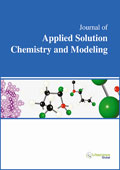jascm
Editor's Choice : Solvatochromic Parameters of the Binary Mixtures of Imidazolium Chloride Ionic Liquid Plus Molecular Solvent
|
|
Abstract: Imidazolium-based chloride ionic liquids (ILs) have exhibited remarkable performance in several important applications such as biomass dissolution and extraction, but their large viscosity is a non-negligible problem. Adding molecular co-solvents into chloride ILs is effective in reducing viscosity; nevertheless, understanding of the accompanied change of thermodynamic polarity is quite few. Therefore, in this work we reported three Kamlet-Taft solvatochromic parameters, including dipolarity/polarizability (ð*), hydrogen-bond acidity (α) and hydrogen-bond basicity (β), for the binary mixtures of several imidazolium-based chloride ILs plus either dipolar protic solvents (water and methanol) or dipolar aprotic solvents (dimethyl sulfoxide, N,N-dimethylformamide and acetonitrile). The results demonstrated that those parameters could be altered by the structure of IL and type of co-solvent owing to the solute-solvent and solvent-solvent interactions. The structure of alkyl chain of cation had considerable impact on the ð* variation of IL aqueous solution against IL concentration but hardly affected other mixtures. Moreover, remarkable preferential solvation of probes was observed for β and α in the mixtures of IL and dipolar aprotic co-solvents, whereas the hydrogen-bond interactions between IL and dipolar protic co-solvent enabled the preferential solvation to be alleviated and resulted in more linear variation of β and α against the molar fraction of IL. The results not only contribute to a better understanding of the effect of co-solvent on imidazolium-based chloride ILs, but also are instructive for improving the thermodynamic performance of IL-based applications via providing IL+co-solvent mixtures with desirable physicochemical properties. Keywords: Polarity, hydrogen bond, basicity, acidity, preferential salvation.Download Full Article |
Editor’s Choice : Effects of Additives upon Percolation Temperature in AOT-Based Microemulsions
|
|
Abstract: In the present review the percolative phenomena has been analyzed. Percolation is related to transport phenomena in microemulsions, in particular the electric charge transport. The influence of different additives upon electric percolation has been commented. The effects of the additives considered upon the microemulsion properties appear to come about through their association with the surfactant interface. The effects of these agents on the ease with which interdroplet channels allowing transfer of droplet contents are formed are not only responsible for their effects on percolation temperature, but also have serious implications for the rates of fast chemical reactions performed in microemulsions. Keywords: Microemulsion, Surfactants, Transport phenomena, Percolation, Aditives, Percolation Temperature.Download Full Article |
Editor’s Choice : Excess Volume of Binary Mixtures of Water (Methanol or Ethanol) with an Ionic Liquid [EEIM][DEP] or [BEIM][DEP] at 1 atm and (293.15 to 333.15) K
|
|
Abstract: Densities were measured for the binary mixtures of water (methanol or ethanol) and an ionic liquid (IL) 1,3-diethylimidazolium diethylphosphate [EEIM][DEP] or 1-n-butyl-3-ethylimidazolium diethylphosphate [BEIM][DEP] at 1 atm and (293.15 to 333.15) K using a vibrating-tube densimeter. The molecular volume, standard entropy, and lattice energy of the two ILs were estimated with the Glasser theory. The excess volumes are negative for all binary mixtures studied in the whole composition range, and reach to the maximum at the mole fraction of IL being around 0.3. Besides, they decrease with increasing temperature for the aqueous solution of ILs, whilst a reverse trend is found for the IL solutions of methanol or ethanol at any concentration. The excess molar volumes were correlated successfully by a five-parameter polynomial equation as a function of temperature and mole fraction of IL with average absolute relative deviation (ARD) of density within 0.02%. Keywords: Density, excess volume, ionic liquid, water, methanol, ethanol.Download Full Article |
Editor’s Choice : Preferential Solvation of Acetaminophen in Propylene Glycol + Water Co-Solvent Mixtures
|
|
Abstract: The preferential solvation parameters defined as the differences between the local mole fraction of solvents around analgesic drug acetaminophen and those for the bulk co-solvent composition in propylene glycol + water mixtures were derived from their thermodynamic properties by means of the inverse Kirkwood-Buff integrals (IKBI) and the quasi-lattice-quasi-chemical (QLQC) methods. It is found that acetaminophen is sensitive to solvation effects, so according to IKBI method the preferential solvation parameter δxPG,A, is negative in water-rich mixtures but positive in medium compositions and in co-solvent-rich mixtures. It is conjecturable that in water-rich mixtures the hydrophobic hydration around the aromatic ring and methyl group present in the drug plays a relevant role in the solvation. The bigger drug solvation by co-solvent in mixtures of similar solvent proportions and in propylene glycol-rich mixtures could be due mainly to polarity effects. Otherwise, according to QLQC method, this drug is preferentially solvated by the co-solvent in all the mixtures. Keywords: Acetaminophen, propylene glycol, solubility, inverse Kirkwood-Buff integrals, preferential solvation.Download Full Article |






















